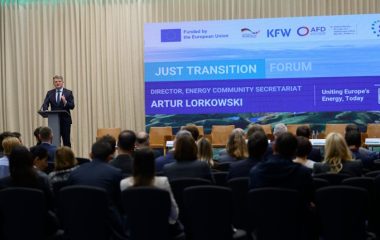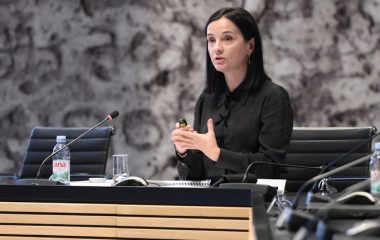
Photo: Energy Community
Achieving results in energy efficiency is not a question of available financing instruments, but a matter of creditworthiness of households and their disposable income for energy efficiency improvements, Violeta Kogalniceanu, Head of the Infrastructure and Energy Efficiency Unit at the Energy Community Secretariat, says in an interview with Balkan Green Energy News. According to her, in order to scale up the renovation rate, governments would need to develop comprehensive nation-wide energy efficiency programmes.
Kogalniceanu says that infrastructure has not obstructed the uptake of renewables in the Western Balkans so far, but that it will have to adapt to the next renewables phase once it starts.
How large is the untapped potential for increasing energy efficiency in member countries of the Energy Community?
Nowhere else in Europe does energy efficiency have such great potential than in the Energy Community Contracting Parties. For the Western Balkans, various IEA and World Bank estimates point to potential savings of up to 10% in the transport sector, up to 40% in buildings and the public sector and up to 25% in industry and commerce.
While it is important to recognize the progress that was achieved to date, much more remains to be done to attain EU energy efficiency standards. In terms of sectors with the biggest potential, it is clearly the public and residential buildings sector where the most savings lie and this is also a big focus of our activities in the Energy Community.
Nowhere else in Europe does energy efficiency have such great potential than in the Energy Community Contracting Parties
What are the main drivers of increasing energy efficiency, and what are the main obstacles?
The main drivers are industrial competitiveness, decreasing household energy bills, a healthier living environment, by this I mean better lit and heated/cooled schools, hospitals, offices, etc., cleaner air, job creation and, in general, economic development through investments in energy efficient technologies and buildings.
The main obstacles remain the lack of awareness of the multiple benefits of energy efficiency, especially in buildings (residential, commercial); in some of the Western Balkans (Serbia included), the level of energy prices does not reflect fully the cost of supply and, hence, investments in energy efficient equipment or buildings renovation may need a longer period to be recovered; for residential multi-apartment buildings, the challenge is the legal status of homeowners’ associations and the capacity to borrow money from commercial banks, etc.
The level of energy prices does not reflect fully the cost of supply and, hence, investments in energy efficient equipment or buildings renovation may need a longer period to be recovered
It appears that there are more projects to improve energy efficiency in public buildings than in households, and that the effects are consequently stronger in the public building segment than in the household segment. What are your comments?
Indeed, the “move” towards energy efficient buildings started with the public sector, which is easier to “engage” from the financing and implementation viewpoint. But things are changing with the Green Economy Financing Facility (GEFF). The GEFF has just been launched in Serbia with EUR 10 million, but it is expected to grow if the market asks for it. This was the case in Bosnia and Herzegovina that started with EUR 10 million and just within a few months grew to EUR 22 million.
However, to be frank, attaining results is not a question of available financing instruments from international financial institutions or local banks. It’s a matter of credit worthiness of households, their disposable income for energy efficiency improvements, etc. To scale up the rehabilitation rate of households, especially in multi-apartment buildings, the government would need to develop a comprehensive nation-wide programme for energy efficiency, which would facilitate the application process for the applicant by bringing finance and construction works together.
Comprehensive nation-wide programme for energy efficiency would facilitate the application process for the applicant by bringing finance and construction works together
Can you tell us something more on the Green Economy Financing Facility (GEFF), launched by the European Bank for Reconstruction and Development (EBRD)?
Indeed, this is a very important step forward on the financing map of energy efficiency in the Western Balkans. Nevertheless, apart from EBRD’s contribution, this would probably not have been possible, without the EU’s financial contribution in the form of grant incentives to residential borrowers, the Austrian Ministry of Finance for the technical assistance in implementing GEFF, and, last but not least, the Energy Community Secretariat for its assistance with the legal framework.
The price of electricity in most of the Energy Community Contracting Parties is below the market price. Is this the biggest demotivating factor for investing in energy efficiency?
Indeed, it is still not reflecting the true costs of supply, but when markets will be fully liberalized, the price signal will become a strong driver.
In spite of this, many households are investing in energy efficiency as we speak, because the deep renovation of buildings brings additional benefits: higher level of comfort, healthier living, better-heated homes, etc. Having in mind that GEFF is a dedicated financing facility that includes significant technical support in preparing the bank application and also grant incentives from the EU funding, it should be able to support the market demand for energy efficient technologies in residential buildings.
GEFF includes significant technical support in preparing the bank application and also grant incentives from the EU funding
Energy efficiency can also be increased on the supply side. It seems that these projects are very rare in the Energy Community Contracting Parties. Why?
In fact, this is slowly beginning to change. There are more recent developments, such as a Fund for Renewable District Energy in the Western Balkans (REDEWeB) being set up under the management of EBRD and the financial support of the Austrian Ministry of Finance. And international financial institutions, like KfW, are financing the conversion of some coal fired district heating plants in Serbia to biomass use.
New supply-side measures will be implemented by distribution and transmission system operators once they evaluate their savings potential according to the Energy Efficiency Directive. Moreover, on the demand side, suppliers may be obligated to deliver efficiency improvements at customer level to contribute to the energy efficiency national target, as prescribed by the Directive.
New supply-side measures will be implemented by distribution and transmission system operators once they evaluate their savings potential according to the Energy Efficiency Directive
What is the pace of the implementation of the current Energy Community acquis in the energy efficiency sector? Is there any new regulation in the pipeline?
Currently, the Energy Efficiency Directive and the Energy Performance in Buildings Directive are the focus of implementation activities in the Contracting Parties. Regarding the state of implementation, our newest assessment, to be unveiled in the Secretariat’s Implementation Report 2018 to be published at the end of October, shows that while the majority of the legislation has been transposed, implementation remains a big challenge in the majority of the Contracting Parties. Almost all of them lack the necessary secondary legislation, including ESCO supporting legislation, effective energy efficiency funds, and the necessary institutional and human capacities.
Almost all Contracting Parties lack the necessary secondary legislation, including ESCO supporting legislation, effective energy efficiency funds, and the necessary institutional and human capacities
Both Directives require a significant number of secondary legislation (decrees, rulebooks) to be adopted and involve many stakeholders: building ministries, local authorities, industry, ministries responsible for energy efficiency, agencies responsible for energy efficiency, funding institutions, etc. In most countries in the Western Balkans, there is a chronic lack of human resources available in all the institutions involved and, despite the significant technical assistance received, the process of development and adoption of the secondary legislation remains slower than expected.
A new Regulation on energy labelling is being proposed for adoption at the Ministerial Council in November this year. This Regulation will replace Directive 2010/30/EU and reform the existing labelling system. The Regulation establishes deadlines to replace the current A+, A++, A+++ classes with an A to G scale in order to increase the understanding of the system by consumers and further promote energy efficiency. The implementation deadline will be decided by the Ministerial Council at its meeting on 29 November in Skopje.
New Regulation on energy labelling is being proposed for adoption at the Ministerial Council in November this year
What are the infrastructural bottlenecks concerning the transmission of electricity in the Energy Community Contracting Parties?
The Energy Community has adopted in October 2015 the EU Regulation 347/2013 on Guidelines on Trans-European energy networks, which is streamlining and simplifying the permitting process for construction of new lines and pipelines. To date, the permitting process appears to be one of the biggest bottlenecks. In addition, the investment decision usually takes a long period to be taken.
What does the Energy Community do to speed up the construction of this missing infrastructure?
The same Regulation has also in its scope the identification of priority energy infrastructure Projects of Energy Community Interest; the 2016 list is being renewed in 2018 and this should result in a faster implementation and permitting procedure. The new list will be adopted at the November Ministerial Council.
Renewables have been rather hindered by the lack of adequate investment incentives and complex and lengthy permitting procedures
How much does the lack of infrastructure hinder the development of renewable energy sources?
Today’s energy infrastructure is still not well suited for handling large amounts of energy from renewable as well as increasingly local energy sources. Transmission and distribution grids need reinforcements to cope with the volatile electricity generation.
When we talk about the specific case of the Western Balkans, infrastructure, at least until now, has not obstructed the uptake of renewables. This is because the development of large-scale volatile renewables (wind and solar PV) has not yet taken off at the desired scale. At present, renewables have been rather hindered by the lack of adequate investment incentives and complex and lengthy permitting procedures. Infrastructure will have to adapt to the next renewables phase once it starts.









Be the first one to comment on this article.